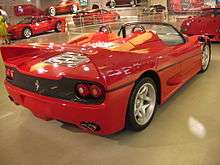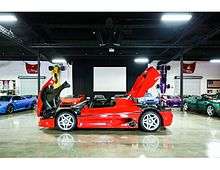Ferrari F50
| Ferrari F50 | |
|---|---|
 | |
| Overview | |
| Manufacturer | Ferrari |
| Production | 1995–1997 & 2001[1] (349 produced) |
| Assembly | Maranello, Italy |
| Designer | Pininfarina |
| Body and chassis | |
| Class | Sports car (S) |
| Body style | Berlinetta/Barchetta |
| Layout | RMR layout |
| Related | Ferrari F50 GT |
| Powertrain | |
| Engine | 4.7 L DOHC 65 degree V12[2] |
| Transmission | 6-speed manual |
| Dimensions | |
| Wheelbase | 2,580 mm (101.6 in) |
| Length | 4,480 mm (176.4 in) |
| Width | 1,986 mm (78.2 in) |
| Height | 1,120 mm (44.1 in) |
| Curb weight | 1,397 kg (3,080 lb) [3] |
| Chronology | |
| Predecessor | Ferrari F40 |
| Successor | Enzo Ferrari |
The Ferrari F50 is a mid-engined range-topping sports car made by Ferrari. The F50 was introduced in 1995. The car is a two-door, two seat roadster with a removable hardtop. It has a 4.7 L naturally aspirated 60-valve V12 engine that was developed from the 3.5 L V12 used in the 1990 Ferrari 641 Formula One car.
Only 349 cars were made. The last F50 was produced in Maranello, Italy, in July 1997.
The F50's engine predated the car; it was used in the Ferrari 333 SP for the American IMSA series in 1994, allowing it to become eligible for the stock engine WSC category.
Racing
Following the motorsport theme, Ferrari developed the F50 GT, a prototype based on the F50 that was built to compete in GT1-class racing. The car had a fixed roof, large rear spoiler, new front spoiler and many other adjustments. The 4.7 litre V12 engine was tuned to generate around 750 bhp (559 kW). In testing in 1996 the car proved to be quicker even than the 333SP, but this went unnoticed as Ferrari cancelled the F50 GT project, instead focusing on Formula One. Ferrari sold off the three complete chassis that were built–the test car 001, 002 and 003. Chassis 002 and 003 had bodies fitted before being sold. The remaining three tubs were reportedly destroyed.
A custom-made F50 variant named the Bolide was commissioned by the Sultan of Brunei in 1998 and delivered in the same year. It used the F1 derived V12 engine and the same chassis, but was completely redesigned due to the monocoque construction of the body on the F50. One car was produced in the coupe configuration. Very few images and no official performance statistics of this car are available. At least one car was produced in RHD for the sultan, and was subsequently bought by a collector in Ireland.
Specifications

General
- Manufactured in: Maranello, Italy
- Number produced: 349 (1995 to July 1997)
- Inspiration: 1990 Ferrari 641 as driven by Alain Prost

Dimensions
- Dry weight: 2712 lb (1230 kg)
- Distribution: 42%/58 % (front/rear)
- Length: 177 in (4,496 mm)
- Height: 44.1 in (1,120 mm)
- Width: 78.2 in (1,986 mm)
- Wheelbase: 101.6 in (2,581 mm)
- Front track: 63.8 in (1,621 mm)
- Rear track: 63.1 in (1,603 mm)
Engine
- Type: Tipo 040-derived, model SFE 4.7 VJGAEA
- Position: mid-engine, rear-wheel drive
- Configuration: longitudinal 60-valve 65° V12, derived from F1 unit
- Aspiration: natural, with variable length intake manifold via butterfly valve in intake manifold
- Intake manifold: carbon fiber
- Block: nodular cast iron
- Heads/Pistons: might-alloy aluminum heads/forged Mahle pistons
- Oil sump: aluminium
- Connecting rods: forged titanium
- Crankshaft: forged steel
- Cam covers/Oil and water pump housing: magnesium sand castings
- Exhaust manifold: stainless steel
- Engine weight: 436.5 lb (198.0 kg)
- Timing gear: 5 valve/cyl (3 intake, 2 exhaust), 4 overhead camshafts (2 per cylinder bank) driven by low-noise Morse chain
- Displacement: 4698 cc/286.68 ci
- Max. power: 520 PS (382 kW; 513 hp) @ 8000 rpm
- Max. torque: 347 lb·ft (470 N·m) @ 6500 rpm
.jpg) Ferrari F50 engine
Ferrari F50 engine - Power/Disp.: 109.1 bhp/litre
- Weight/Power ratio: 5.8 lb/bhp
- Bore x Stroke: 3.35 in (85 mm). x 2.72 in (69 mm)
- Bore:Stroke ratio: 1.23:1 (oversquare)
- Compression ratio: 11.3:1
- Redline: 8500 rpm
- Fuel cutoff: 8640 rpm[5]
- ECU: Bosch Motronic 2.7 (controls the fuel feed, ignition timing, and variable length intake and exhaust systems)
- Fuel feed: Sequential injection
- Ignition: Bosch static electronic distributor-less ignition
- Lubrication: dry sump, tank incorporated within the final drive housing, 3 scavenger pumps
- Variable intake: butterfly valve in carbon fiber intake manifold closed at low rpm, open at high rpm
- Variable exhaust: butterfly valve in upper tailpipes closed at low rpm, open at high rpm
- Fuel tank: foam filled, aeronautical-style Sekur rubber bladder, 27.7 US gal (105 L; 23 imp gal)
Fuel consumption
- EPA premium gasoline[6]
- Combined 8 miles per U.S. gallon (29 L/100 km; 9.6 mpg-imp)
- City 7 miles per U.S. gallon (34 L/100 km; 8.4 mpg-imp)
- Highway 10 miles per U.S. gallon (24 L/100 km; 12 mpg-imp)
Transmission
- Configuration: longitudinal 6 speed manual + reverse, limited slip differential, RWD
- Gear ratios: 2.933:1 (1st), 2.157:1 (2nd), 1.681:1 (3rd), 1.360:1 (4th), 1.107:1 (5th), 0.903:1 (6th), 2.529:1 (reverse)
- Final drive: 3.70:1
- Flywheel: steel
- Final Drive Assembly: aluminum sand casting
- Remaining gearset housing: magnesium sand casting
- Support bracing: steel
- Flywheel: steel
- Clutch: dry, twin plate
- Cooling: oil-water intercooler between gearbox lubricant and engine
Chassis
- Type: central carbon fiber tub, light-alloy suspension and engine-gearbox assembly mounting points co-polymerised to the chassis
- Materials: carbon fiber, epoxy resin, Nomex honeycomb core, sandwich construction
- Weight: 2,249 lb (1,020 kg)
- Torsional stiffness: 25,500 lb·ft (34,570 N·m) per degree
Suspension
- Front: Rose-jointed unequal-length wishbones, push-rods, coil springs, Bilstein gas-pressurised monotube dampers, electronic adaptive damping, electronic height adjustment (40 mm max)
- Rear: Rose-jointed unequal-length wishbones, push-rods, coil springs, Bilstein gas-pressurised monotube dampers, electronic adaptive damping, mounting points on a spacer between the engine and gearbox
- Travel: 55 mm bump, 60 mm rebound
- Camber angle: -0.7 degrees front, -1.0 degrees rear
- Anti-roll bars: front and rear
- Max. roll angle: 1.5 degrees
Steering
- Type: TRW rack and pinion, 3.3 turns lock to lock, unassisted
- Caster angle: 5.5 to 5.7 degrees
- Turning circle: 41 ft (12 m)
Miscellaneous
- Electronic adaptive damping (based on steering wheel angle and velocity, the body’s vertical and longitudinal acceleration, brake line pressure, and vehicle speed)
- Maximum reaction time (from minimum to maximum damping force or vice versa): 140 milliseconds (0.14 sec)
- Average reaction time (from minimum to maximum damping force or vice versa): 25 to 30 milliseconds (.025 to .03 sec)
Wheels/tires/brakes
- Wheels: magnesium alloy, manufactured by Speedline
- Hubs: titanium
- Brake disc bells/suspension uprights/brake calipers: aluminum
- Upper and lower wishbones: black powder-coated steel
- Front wheels: x
- Front tires: 245/35ZR-18 Goodyear Eagle F1 GS Fiorano (35psi)
- Front brakes: Brembo cross-drilled & ventilated cast iron discs, 4 piston aluminum Brembo calipers, Pagid brake pads, (without ABS)
- Rear wheels: x
- Rear tires: 335/30ZR-18 Goodyear Eagle F1 GS Fiorano (30psi)
- Rear brakes: Brembo cross-drilled & ventilated cast iron discs, 4 piston aluminum Brembo calipers, Pagid brake pads, (without ABS)
- Unsprung mass: 99 lb/121 lb (front corners/rear corners)
Colour popularity
- Rosso Corsa (Red): 302
- Giallo Modena (Yellow): 31
- Rosso Barchetta (Dark red): 8
- Argento Nurburgring (Silver): 4
- Nero Daytona (Black): 4
Performance
- 0-48 km/h (30 mph): 1.7 sec [7]
- 0-64 km/h (40 mph): 2.4 sec[7]
- 0-80 km/h (50 mph): 3.0 sec[7]
- 0–97 km/h (60 mph): 3.8 sec [8]
- 0–110 km/h (70 mph): 4.7 sec [7]
- 0–130 km/h (80 mph): 5.5 sec [7]
- 0–140 km/h (90 mph): 7.5 sec [7]
- 0–160 km/h (100 mph): 8.5 sec [8]
- 0–180 km/h (110 mph): 10.1 sec [7]
- 0–190 km/h (120 mph): 11.6 sec [7]
- 0–210 km/h (130 mph): 13.4 sec [7]
- 0–230 km/h (140 mph): 15.9 sec [7]
- 0–240 km/h (150 mph): 18.8 sec [7]
- 0–260 km/h (160 mph): 21.8 sec [7]
- 0–270 km/h (170 mph): 26.8 sec [7]
- 1/4 mile: 12.1 seconds @ 198 km/h (123 mph)[8]
- Skidpad: 0.95g[8]
- Braking 70–0 mph (113–0 km/h): 176 ft (54 m)[8]
- Top speed: 194 mph (312 km/h)[8] (202 mph (325 km/h) claimed[9])
Track Tests
- Tsukuba Circuit: 1:05.81[10]
- Suzuka Circuit(2000): 2:26.525[11]
- Sugo: 1:38.573[12]
- In 2016, an old F50 joined Top Gear's Green Hell challenge in Germany. It completed the track in 7:47, 3 seconds faster than the Dodge Challenger SRT Hellcat but 28 seconds slower than the Mercedes-AMG GT R.[13]
References
| Wikimedia Commons has media related to Ferrari F50. |
- Buckley, Martin; Rees, Chris (1998). World Encyclopedia of Cars. London: Anness Publishing. ISBN 1-84038-083-7.
- ↑ "Ferrari to show Enzo replacement to a select few by the end of the year". Autoweek.
- ↑ Derrick, Martin; Clay, Simon (2013). Million Dollar Classics: The World's Most Expensive Cars. Chartwell Books. ISBN 978 0 7858 3051 1.
- ↑ Phillips, John (January 1997). "Ferrari F50 Road Test Car and Driver" (PDF).
- ↑ http://marconimuseum.org/carcollectiongallery/
- ↑ Ferrari F50 - Car and Driver (PDF)
- ↑ "fueleconomy.gov". Retrieved 11 February 2016.
- 1 2 3 4 5 6 7 8 9 10 11 12 13 "C/D Test Results" (PDF).
- 1 2 3 4 5 6 John Phillips (January 1997). "Ferrari F50 — Why it took 13 months to get our hands on this supercar". Car and Driver. Retrieved 2012-01-14.
- ↑ "Ferrari F50 (1995) - Ferrari.com". Ferrari GT - en-EN.
- ↑ "Best Motoring - Platinum Series Vol. 12".
- ↑ "Best Motoring 2000 Suzuka Super Battle".
- ↑ "Best Motoring Super Car Race f50, 911 Gemballa, GT2, Murcielago, NSX R".
- ↑ "Glory Of The Legends". Top Gear. Retrieved 2016-10-08.
| « previous — Ferrari road car timeline, 1960s–1990s — next » | |||||||||||||||||||||||||||||||||||||||||
|---|---|---|---|---|---|---|---|---|---|---|---|---|---|---|---|---|---|---|---|---|---|---|---|---|---|---|---|---|---|---|---|---|---|---|---|---|---|---|---|---|---|
| Type | 1960s | 1970s | 1980s | 1990s | |||||||||||||||||||||||||||||||||||||
| 0 | 1 | 2 | 3 | 4 | 5 | 6 | 7 | 8 | 9 | 0 | 1 | 2 | 3 | 4 | 5 | 6 | 7 | 8 | 9 | 0 | 1 | 2 | 3 | 4 | 5 | 6 | 7 | 8 | 9 | 0 | 1 | 2 | 3 | 4 | 5 | 6 | 7 | 8 | 9 | ||
| 8 cylinder | Mid-engine berlinetta | 308 | 308 i | 308 QV | 328 | 348 | 360 | ||||||||||||||||||||||||||||||||||
| 208 | 208 Turbo | GTB/GTS Turbo | F355 | ||||||||||||||||||||||||||||||||||||||
| Mid-engine 2+2 | 308 GT4 | Mondial 8 | Mondial QV | Mondial 3.2 | Mondial t | ||||||||||||||||||||||||||||||||||||
| 208 GT4 | |||||||||||||||||||||||||||||||||||||||||
| 12 cylinder | Boxer berlinetta | 365 BB | 512 BB | 512i BB | Testarossa | 512TR | F512M | ||||||||||||||||||||||||||||||||||
| Grand tourer | 250 | 275 | 365 GTB/4 "Daytona" |
550 Maranello | |||||||||||||||||||||||||||||||||||||
| America | 330 | 365 | |||||||||||||||||||||||||||||||||||||||
| 2+2 coupé | 250 GT/E | 330 GT 2+2 | 365 GT 2+2 | 365 GTC/4 |
365 GT4 2+2 | 400 | 400 i | 412 | 456 | 456 M | |||||||||||||||||||||||||||||||
| Supercar | 250 GTO | 250 LM | 288 GTO |
F40 | F50 | ||||||||||||||||||||||||||||||||||||
| Sold under the Dino marque until 1976; see also Dino car timeline | |||||||||||||||||||||||||||||||||||||||||